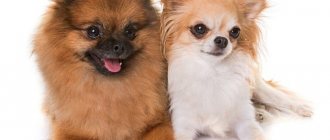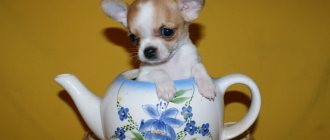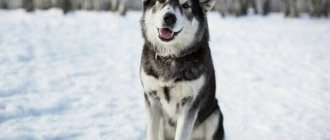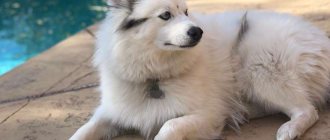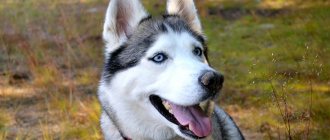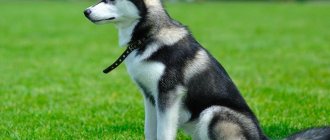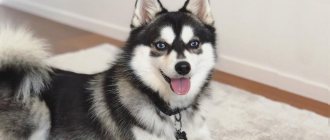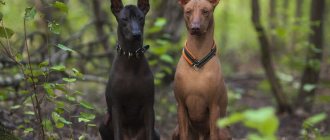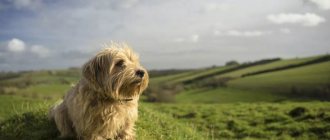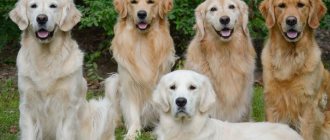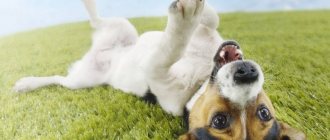Today, many dog breeders prefer to have puppies for beauty, aesthetics and love, since they do not require a special approach to training, daily sports training and the need to live on the street as a guard. In order to develop a new decorative variety, a calm, independent Husky was crossed with a miniature Spitz. As a result, a stunning Pomsky breed was born, which immediately gained love and popularity on the Internet. A pretty appearance and a kind character are the main qualities of a furry, four-legged friend.
Characteristics and description of the breed
Decorative dogs were bred through numerous experiments and experiments. Character traits, like external data, are completely inherited from parents, undergoing genetic changes. At the moment, the breed does not have a large-scale distribution, since it has not been amenable to the study of characteristic features and the development of general standards.
Aggressiveness
They don't know what aggression is. They are absolutely defenseless, so they need a strong, good-natured and attentive mentor. Trying to raise a Pomsky to be a protector is a waste of time and effort.
Activity
Very playful and playful pets. They love to take long walks, run and play. They often make good companions. When the opportunity arises, they will try to escape in search of exciting adventures and fun. Therefore, it is necessary to monitor the dog and teach it from childhood to calmness and moderate activity.
Training
They enjoy training and learning new teams. They love to learn new things. They quickly master standard training and listen to their owner if he pampers them with love and treats.
Pomskies do not tolerate harsh language or threats. If pets are not surrounded by love and affection, they begin to live an independent life without the help of household members.
Shedding
They shed heavily, especially during adolescence. The breed is not suitable for those who are prone to allergies. During the change of undercoat, it is necessary to comb several times a day.
Need for care
They do not require expensive, lengthy care procedures. It is enough to comb the fur during the molting period, clean the ears, eyes and wipe the paws after a walk. Bath once every 2 weeks.
Friendliness and attitude towards children
They are very self-sufficient and freedom-loving, so in some periods they may not pay attention to the people around them and strangers. They also treat children with indifference and sometimes play with them, but without fanaticism.
Health
From birth they have strong immunity and resistance to external irritants. The only caveat is the inheritance of chronic diseases from parents.
Attitude towards loneliness
They cannot stand being alone for a long time; it is important for them to constantly be near their beloved owner. With proper upbringing, they patiently wait for members of the household to arrive and know how to keep themselves busy.
If a dog is alone in an apartment for a long time, it needs entertainment items, such as toys, exercise equipment and special houses.
Maintenance cost
The maintenance depends entirely on the daily diet and type of food, the number of trips to the veterinarian and visits to the hairdresser per month. On average, the amount is similar to that spent on keeping a Pomeranian.
Read Description of the Austrian Smooth-haired Pinscher breed
Intelligence
Developed intelligence and increased learning ability. Pomskies can hardly be called lazy pets; they are always active, determined and attentive.
Noise
They can be silent if properly raised and explained the importance of silence at certain moments. Some “instances” are real talkative fidgets who cannot be calmed down.
Security qualities
There are no security qualities. If danger threatens, the dog can attack the enemy, but most often it is timid and does not know how to defend itself. This is an ornamental breed that does not tolerate conflicts.
Lifespan
The lifespan of a pet is determined by its health and inherited diseases from its parents. On average, dogs live up to 14-15 years.
Life expectancy is determined by proper care, regular examinations and timely vaccinations.
Application
The Hybrid Yorkie is used exclusively as a companion dog. If the crossing was successful, then the puppy will receive devotion, friendliness and affection for the owner from the parents.
Metis is well suited for a single person who has time to raise a pet, or for a family with growing children.
Crossing a Yorkshire Terrier with hunting instincts and a originally guard Spitz may result in some of these qualities being passed on to the offspring. However, you shouldn’t count on this - the characters of the breeds are too different.
Story
Hybridization of breeds is widespread in cynology. Crossing allows you to develop new species, thereby analyzing the compatibility of the qualities of the participating representatives. In this way, the Pomsky breed was created, the parents of which were a female husky and a male Spitz. The purpose of breeding and distribution is to create a miniature, decorative dog with an unusual appearance, sociable qualities and developed mental abilities.
In 2013, Teresa Peterson became the first experimenter to become a breeder of this breed. In the same year, a special organization RSA ("American Pomsky Club") was created, advocating for the rights of a breeding species in its registration as a separate species with certain standards.
After the first successful experience, Pomskies quickly gained popularity among dog lovers, thanks to their beauty and innate friendliness. Photos regularly appear on the Internet depicting miniature “fox cubs” with a bewitching look.
Breeding
To breed a Pomsky, it is enough to take a healthy Spitz male and a healthy Husky female. The main thing in choosing partners is the absence of genetic diseases and marriage.
You can mix two individuals of the same species, but such mating is allowed only in nurseries where there are experienced specialists. The difficulty of such crossing is that the genetic characteristics of the litter are unpredictable. If one mating results in beautiful Pomskys, subsequent ones may result in puppies that are completely different from the first litter. They may have more developed Husky or Pomeranian characteristics.
Mating
The peculiarity of mating is the difference in height between the dog and the bitch. A Spitz cannot naturally impregnate a Husky, so specialists have to resort to the method of artificial insemination. The bitch is injected with male sperm with a special syringe at a certain time of estrus.
It is forbidden to breed a Spitz female and a Husky male, as a small dog will not be able to bear large puppies. This will lead to the death of the animal.
Caring for puppies
The first time after birth, puppies need special care from the mother and the breeder. The owner must provide comfortable conditions for the mother and babies, adequate nutrition for the bitch to maintain natural feeding of the puppies.
When the kids grow up and begin to move independently, they need to be placed in a special enclosure to ensure safety. At this time, the owner should take care of complementary feeding, which consists of low-fat cottage cheese and kefir.
By three months, the puppies will already be socially adapted and transferred to adult food. At this age, the sale of offspring begins.
Appearance
The average weight of first generation males does not exceed 7 kg, height up to 40 cm at the withers. Variability of parameters is characteristic, namely an increase in weight of a couple of kilograms and an increase in body length. The girl's weight is 4-6 kg, height is 25-30 cm. Puppies' height and weight vary depending on their genes.
To accurately determine external characteristics, cynologists distinguish the following exterior types of Pomsky:
- “fox” subspecies - a modified body from a husky and the appearance of an orange. Sharp muzzle, fiery red coat color, semi-long undercoat;
- plush appearance - airy fur and the appearance of a spitz, inherits the color of a husky. A characteristic feature is a large, curled tail;
- white type – snow-white coat and large body;
- brown blue-eyed - large dogs, with a double undercoat. The muzzle is elongated, the color is brown;
- short-haired – the owner of a hard, short coat and the appearance of a Spitz.
Head
The head is small, like a Spitz, proportionate to the body and muzzle. Most often round in shape, small in width.
Eyes
Heterochromia (different eye colors) is characteristic; often there are contrasting spots on the irises. Most have brown, hazel with a yellow tint, blue and green eyes. Round in shape, close set.
Ears
The ears are medium in size and set high. Straight shape, with wool cover. Sometimes they inherit the drooping shape and small size of Spitz dogs.
Read Poodle - circus performer and cheerful friend
Jaws
The jaws are well developed and have a scissor bite, like those of Pomeranians. The teeth are positioned vertically.
Torso
The first litter is elongated, with a strong skeleton. The second group has a miniature body with fragile bones. The rest are the largest representatives, with a developed constitution.
Neck
The neck is short and rounded. It has smooth transition lines and is well developed.
Tail
The tail is not long, fluffy, and set high. The second group has a thick, low-set, curled tail.
Paws
The legs are short with well-developed muscles. The stand is strong, the legs are parallel to each other. The pads are dark, the claws need regular treatment.
Wool
Semi-long, with dense undercoat. Regularly updated and requires maintenance.
Color
The most popular color is smoky shades with an unusual mask on the face, namely: black and white, silver, gray fawn, brown, gold and copper tones. Mixed or single color is acceptable.
Mating
Dogs are very carefully selected for mating a Yorkshire Terrier with a Spitz. Representatives of both breeds should be in exceptional health, without any congenital pathologies. In addition, animals with defects in appearance or color are excluded from the list of possible partners.
The main criterion is the appearance of the animals, since a cross between a Spitz and a Yorkie will receive partial characteristics of both breeds. However, it is impossible to guarantee the appearance of at least one specific sign in a York Spitz, because even in the same litter there can be puppies completely different from each other.
The successful result of crossing is influenced by compliance with the following requirements:
- parents are purebred representatives of their breeds;
- both dogs are mixed breeds of the same breeds with equal shares;
- partners have access to mating.
Character
Character is formed in the process of education and growing up. Most often, dogs are sociable, friendly and freedom-loving. They are content with the company of people.
They are non-conflict, do not feel competition when meeting strangers. They get along with other pets, or rather, they do not pay attention to them until certain moments. Negative traits include a tendency to run away and excessive activity.
The dog inherits all its traits from its parents. But due to the fact that the dog is prone to learning, its peculiar disposition can be improved.
They love children, but outwardly show indifference to them. Most often they play and communicate with them without harming them.
Appearance
The appearance of dogs obtained as a result of crossing different breeds is not subject to standardization and is
random character. It is generally accepted that puppies inherit the most attractive parts of the exterior from their parents.
At the birth of hybrids, quite often not only parental traits appear, but also signs of distant ancestors: The growth of puppies as they grow older may differ. It is difficult to imagine in advance the dimensions and height at the withers of an adult mestizo.
Since Yorkies are produced by mating breeds of similar size, it can be assumed that the offspring will not exceed them.
The color and quality of the Yorkie's coat can be inherited from either parent, or a combination of both.
The Fédération Cynologique Internationale does not recognize the Spitz-Yorkie cross as a separate breed; such dogs cannot participate in exhibitions or receive awards.
Maintenance and care
For proper care, the main thing is to visit the veterinarian in a timely manner and follow the principles of proper nutrition.
Nutrition
Nature has endowed Pomskies with a fast metabolism and a “strong” stomach, so a special diet is not required. Changes in diet are resorted to only in case of regular participation in various competitions and events.
Mestizos eat simple food. The optimal diet should consist of the following products:
- lean meat, boiled offal;
- rice or oatmeal porridge;
- boiled or steamed seasonal vegetables;
- low-fat fermented milk products.
The simplest option is to switch to premium dry food. They contain a vitamin-mineral complex and natural ingredients. At the same time, dry kibble helps puppies sharpen their strong teeth.
Dry food should be introduced into the diet gradually. It is better to start at a young age, giving the puppy minimal portions of a few grams.
Hygiene
The fur perfectly protects them from dirt, dust and high humidity, so there is no need for frequent bathing. It is enough to perform skincare procedures a couple of times a month using special detergents. Then the hairs are dried with a soft towel and dried with a hairdryer on low heat.
Thick coats need to be combed, especially during shedding periods. In normal times, comb out a couple of times every 7 days.
You also need to keep an eye on the ears and eyes. Regularly clean them of secretions with a cotton swab. In this case, it is better not to use special cleaning products so as not to injure the mucous membrane.
Read Prague Rat - description and photo of a miniature dog
Health and illness
Teeth and eyes are especially vulnerable. Over time, tartar or tooth decay may develop and can be easily treated. By maturity, the former acuity of vision and smell is lost. Allergic reactions may also develop, so you need to monitor your diet. The most dangerous thing is genetic diseases transmitted from parents.
Mating
In most cases, Pomskies are bred artificially by inseminating a Husky bitch with genetic material from a Pomeranian male. When mating mestizos, fertilization occurs naturally. The only thing is that the parents must be of the same subspecies.
Walks
The average duration of a walk is at least 1.5 hours twice a day with a light jog. This will be enough to satisfy the Pomsky's innate need for freedom. In the opposite situation, the pet will not be upset if it stays at home.
Health
On average, a Pomski can live to be 14-16 years old.
Regarding health, these mestizos are almost problem-free. Thanks to the heterosis effect, Pomskies do not suffer from hereditary diseases. But, like all living beings, this dog also has health problems.
They mainly arise due to poor nutrition and improper living conditions.
The most common problems with Pomskies are:
- Dental diseases – tartar, early tooth loss.
- Allergic reactions – most often occur to detergents, but food allergies can also occur.
- Eye diseases are more often observed in dogs that have reached 6-7 years of age; young dogs rarely suffer from such problems.
It is important to carry out flea and tick treatment on time, especially in the warm season. Regular deworming and routine vaccination should not be ignored.
Once a year, visit a veterinary clinic with your pet, where the dog will be examined by specialists, undergo an X-ray examination and undergo tests.
Pros and cons of the breed
Owners of handsome mestizos highlight the following advantages:
- Developed mental abilities, which allows the dog to easily learn training commands.
- Friendliness and lack of conflict will never provoke a conflict situation with other dogs. Enjoys communicating with other people and children.
- Lack of aggression even when influenced by external stimuli.
- Independence - will be able to stay alone for a long time without requiring undue attention.
- Calmness and affectionate attitude towards loved ones, especially the owner.
Disadvantages include:
- Lack of a standard for mestizos - participation in official Pomsky exhibitions is not yet possible, since the breed is not registered in the appropriate registry.
- With each litter - new character traits, predisposition to genetic diseases and external features.
- They grow up either very active or very lazy, but always require regular walks. This factor can be corrected with education and patience.
Selecting food
Providing the right diet for your Pomsky couldn't be easier. In terms of taste preferences, this dog is no different from other domestic dogs. Therefore, you can feed this breed either regular dry food or natural food. The main rule in this case is to observe the optimal amount of proteins, minerals, fats, vitamins and other nutrients consumed by the dog. But there are contraindications in the diet of this animal.
First of all, in order to maintain the health of the Pomsky for many years, the dog should never be given:
- fatty or smoked foods;
- sweets;
- excessively salty foods;
- flour;
- raw meat or fish.
Important! When choosing the type of food for your Pomsky, it is recommended to opt exclusively for natural food. Only in this case will it be possible to provide the animal with all the necessary substances for active growth and vital activity.
Photo
Purpose
The main purpose of the mestizo is as a companion. In 2011, American cynologists became interested in breeding Pomsky dogs, the first litter was received two years later by Teresa Peterson, and the puppies were officially recognized. However, international organizations have not recognized the breed; so far only hybrid clubs support it. Mestizos are confidently winning the hearts of lovers of these animals, and the demand for them among the population is growing.
How to choose a puppy
Before buying a puppy, you need to check with the breeder about the generation of the hybrid of the current offspring.
The first generation is considered the most valuable, due to its “harmonious” appearance and good health. To find out the character of the baby, you need to get to know one of his parents and observe his behavior. In the first months of life, eye color changes shade. If you want to buy a brown-eyed mestizo, you should wait about three months for the final formation of the iris. After purchase, any breeder must provide:
- pedigree;
- international veterinary passport;
- certificate of registration in the RSA or ASNS.
Types of dogs
If you are wondering “how to tell the breed of a dog from a puppy,” you need to know what type of dog different breeds are. Currently there are several types:
- Purebred, purebred, thoroughbred. Representatives of this group have a pedigree and a special electronic chip with a number. In addition, such a pet is branded. To find out about the origin of an animal, including its ancestors, just contact the staff of a veterinary clinic or a trusted kennel club.
- Phenotype. If your pet is the spitting image of a “German” (we are talking about a German shepherd) or a dachshund, but it does not have the appropriate documentation, then until it receives a “zero pedigree” it will be considered outbred.
- Metis. This definition includes all four-legged friends of uncertain origin, those whose parents do not belong to breed groups. If you intend to buy a puppy from a purebred female, but an unknown male, most likely you will have to deal with the fact that your pet will begin to show signs of mongrel or a mixture of phenotypes.
Distinctive features
There are several types of breed: the Deer (or Deer) and the Cobby Chihuahua. The deer type is characterized by a small chest, narrower muzzle and large ears. She is lighter in weight compared to the stocky Chihuahua Cobby. Both types have an apple-shaped head, but the cobby has a more massive head, the ears are widely spaced, and the bones are larger and denser. The body itself is muscular.
Unlike its predecessor, it has shorter legs and its coat is thicker. They also differ in character. Huashka Kobi will not bark for any reason. She has a calmer character and is better at obedience.
It is impossible to say that there is a pure type of cobby in Chihuahuas, because this is not correct. Professional breeders subdivide the breed only by its coat type. Representatives of one type may exhibit some characteristic features of another type.
Two representatives of the same breed
How much does a Chihuahua cost?
Outbred puppies without documents cost 5-15 thousand, but it’s good if it grows into a dog at least phenotypically similar to a Chihuahua.
A good pet and breeding class with RKF documents costs 15-25 thousand rubles. The price of a mini and show class Chihuahua is higher, from 25 to 50 thousand rubles. The most fashionable and therefore expensive are supermini dogs weighing from 0.5 to 1 kg, fitting in the palm of your hand. Their price can reach 100 thousand or more. Unfortunately, such dogs cannot boast of health and longevity, and “pocket” bitches should absolutely not be bred, so such dogs are more of an expensive and fashionable accessory.
Training
Pomskies can sometimes be difficult to train. Education requires Olympic patience from the owner. Owners often ask experienced dog trainers for help. Dogs are very sensitive and require a gentle approach, otherwise they can become withdrawn and show signs of irritability.
You can’t scold a student for a long time; you need to praise them more. Sometimes they are very stubborn and willful. Once they reach adulthood, Pomskies have the habits of puppies. You should ensure their need for physical activity, then you can easily achieve success in raising them.
